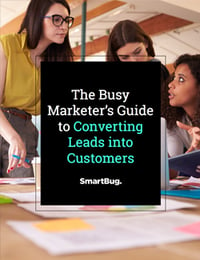
6 Content Offer Examples for the Bottom-of-the-Funnel
May 25, 2016
The buyer’s journey is extremely helpful for marketers in mapping out content to align with where people are in the purchasing process. Whether you use the Awareness -> Consideration -> Decision model or the sales funnel model; ToFu -> MoFu -> BoFu, they both describe a similar process we all go through leading up to a purchase.
Leveraging your existing content and mapping it out with the buyer’s journey is a great tactic for nurturing leads, but how do you go about creating new content?
Coming up with ideas for top-of-the-funnel (or ToFu- not to be mistaken by the vegetarian protein) is often easier than other stages as there's a ton of room for creativity. In this stage, content should be purely educational and unbranded, helping the reader identify their problem. Examples of ToFu offers include:
- Blog posts
- eBooks
- White papers
- Checklists
Next, the buyer trickles down to the middle-of-the-funnel (or MoFu). Now, the buyer has established their problem and has begun researching alternatives. Content in this stage should provide reasons to justify buying your product or service. Common MoFu content offers include:
- Case studies
- Comparison guides
- Videos
But what about that critical period after your buyer has all the right information, has done their research on alternatives but still hasn’t purchased? This is when the BoFu offer steps in. Content at this stage needs to be strategically thought out and be extremely targeted to the persona. A common offer marketers promote at this stage is a product demo, but what if that’s not an option for your business?
Here are some ideas for relevant consideration stage or bottom-of-the-funnel offers (that aren’t demos) to help you accelerate conversions with your buyers:
1. Trial
If it’s within your scope, offering a free trial of your product or service has a few benefits:
- It can convert the skeptical. Once someone uses your product and likes it, they draw to the conclusion themselves that they are interested in purchasing
- You can gain trust
- You reduce the risk of the product/service not meeting their expectations
A free trial is a lot like a sample, which is an effective strategy in marketing. Giving them the chance to try out the product gives the buyer that last push they may need to become a customer.
2. Consultation
A consultation is a great way to get on the phone with a lead. It allows your business to get to know the individual and get a clearer idea of their problems and concerns. Not only can you build a relationship with that particular lead, this knowledge will help you improve your services and better develop your products and marketing strategy.
3. Add-on
Providing buyers with a free add-on to be used with your existing product or service line can encourage a purchase immensely. This isn't always an option when creating new content that easily integrates with your existing resources (and products). Many online retailers use the 'free gift' as an add-on incentive to increase average order size, or get rid of a product that isn't selling well.
4. Audit/Assessment
A lot like a consultation, an audit or assessment is a highly valuable resource for your lead, however, it’s not easily scaled. It generally requires some research and insight on your end, in order to be truly effective for the persona. As your business grows, you need to determine whether or not you have the capacity to conduct audits on a consistent basis.
5. Template
A template is a great BoFu offer if you can be sure it’s completely relevant to your persona. If it’s not useful and is similar in nature to the awareness and consideration stage offers they’ve already acquired from you, you risk converting a lead into a customer. But with a solid understanding of your personas and their typical buyer's journey, a template that helps them solve their problem and further builds trust can help accelerate conversions.
6. Introductory Incentives
Introductory incentives are given to the customer at the onset of a purchase to reduce any uncertainty. Examples of this include:
- 2 for 1
- Free shipping
- Complimentary training
- 12 month subscription for the price of 6
- Additional licenses
These incentives should be easy sells; simple to understand in one sentence and easily communicated with a call-to-action. Complicated formulas or rules will only confuse your leads and potentially push them away at a very critical stage.

About the author
Andrea Moxham formerly was an Associate Consultant at SmartBug Media. She takes an eager and proactive approach to digital and inbound marketing methods, to help clients grow their businesses. Read more articles by Andrea Moxham.







